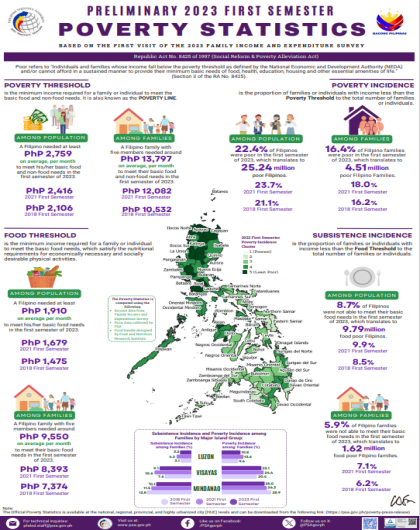Preliminary 2023 First Semester Official Poverty Statistics
Family
a group of persons usually living together and composed of the head and other persons related to the head by blood, marriage or adoption. It includes both the nuclear and extended family.
Reference: Resolution No. 11, Series of 2003
Board Resolution: Resolution No. 12 - Series of 2008
approved: 6/11/2008
Family Expenditures
The expenses or disbursements made by the family purely for personal consumption during the reference period. These include: - Total value of all items of consumption/expenditure bought on credit during the reference period as well as services availed of within the same period that have not been fully paid at the time of visit. - Value consumed from gifts, support, assistance or relief in goods and services received by the family from friends, relatives and imputed rent of owner-occupied dwelling unit. '- Gifts, support, assistance or relief in goods and services donated by the family to friends, relatives and others like tithes, contribution to church, etc. - Imputed value of goods/ services received as fringe benefits from employer or part of the salaries/wages of employed family members.
Notes: . They exclude all expenses in relation to farm or business operations, investment ventures, purchase of real property and other disbursements, which do not involve personal consumption. b. Cash and in kind payments made during the period for items bought on credit prior to the reference period are not included. refer to the value of produce/receipts minus operating expenses such as seeds, fertilizer, pesticides, insecticides, irrigation, etc. d. Consistent with the treatment of family income, expenditure is imputed for own-produced goods consumed by the family. e. Total expenditures for the whole year are estimated from the expenditures captured during the reference period; e.g. when the reference period is the past week, expenditures for the week are multiplied by 26 weeks to account for the semester’s expenditure. Thus, the total expenditure for the year for the particular expenditure item would just be the sum of the expenditures for the first and second semesters.
Reference: FIES
Board Resolution: Resolution No. 12 - Series of 2008
approved: 6/11/2008
Family Income
The primary income and receipts from other sources received by all family members during the reference period, as participants in any economic activity or as recipients of transfers, pensions, grants, interests, food and non-food items received as gifts by the family. Primary income includes: - Salaries and wages from employment - Commissions, tips, bonuses, family and clothing allowance, transportation and representation allowance and honoraria - Other forms of compensation and net receipts derived from the operation of family-operated enterprises/activities and the practice of a profession or trade Income from other sources includes: - Imputed rental values of owner-occupied dwelling units - Interests - Rentals including landowner’s share of agricultural products - Pensions, royalties and dividends from investments - Gifts, support in any form (physical, material and financial) and the value of food and non-food items received as gifts by the family (as well as the imputed value of services rendered free of charge to the family). - Cash received out of salaries/wages and other sources of income of a family member who is a contract worker abroad and also cash receipts sent by a family member/relative of the household with a status of residency abroad other than that of a contract worker - Receipts from family sustenance activities, which are not considered as family operated enterprise.
Notes: - Receipts that are not considered as family income are those which do not come from earnings, property income and gifts received by the family. Examples are loans borrowed from the bank or from other sources, withdrawal from savings account, cash surrender value of insurance, sale of real or personal properties (gains realized from the sale, however, is considered as income), payments received from loans granted to others, inheritance, profits from sale of stocks and bonds and net winnings from gambling and sweepstakes - Net receipts refers to the value of produce/receipts minus operating expenses such as seeds, fertilizer, pesticides, insecticides, irrigation, etc.
Reference: Family Income and Expenditure Survey (FIES)
Board Resolution: Resolution No. 12 - Series of 2008
approved: 6/11/2008
Food threshold (FT)
the minimum income/expenditure required for a family/individual to meet the basic food needs, which satisfies the nutritional requirements for economically necessary and socially desirable physical activities
FT=(cost per capita of the one-day food menu) x (30.4 days/month) x 12 months
Reference: 1997 Philippine Poverty Statistics
Board Resolution: Resolution No. 2 - Series of 2007 approved: 2/14/2007
Gini ratio
the ratio of the area between the Lorenz curve and the diagonal (the line of perfect equality) to the area below the diagonal
Notes: It is a measure of the extent to which the distribution of income/ expenditure among families/individuals deviates from a perfectly equal distribution, with limits 0 for perfect equality and 1 for perfect inequality.
Reference: Notes on the Official Poverty Statistics in the Philippines, Series 2003-1, NSCB
Board Resolution: Resolution No. 2 - Series of 2007 approved: 2/14/2007
Income Gap
The average income shortfall, expressed in proportion to the poverty threshold, of families/individuals with income below the poverty threshold
Notes: The difference between the income gap and the poverty gap is the use of number of poor families/ individuals as denominator for the income gap. For the poverty gap, the total number of families/individuals is used.
Reference: 1997 Philippine Poverty Statistics
Board Resolution: Resolution No. 12 - Series of 2008 approved: 6/11/2008
Poverty gap (PG)
the total income/ expenditure shortfall (expressed in proportion to the poverty threshold) of families/ individuals with income/ expenditure below the poverty threshold, divided by the total number of families/ individuals
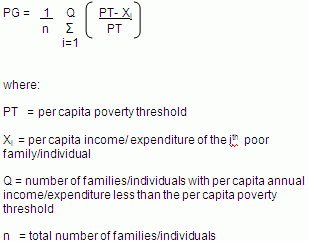
Reference: 1997 Philippine Poverty Statistics
Board Resolution: Resolution No. 2 - Series of 2007
approved: 2/14/2007
Poverty incidence (PI)
the proportion of families/individuals with per capita income/expenditure less than the per capita poverty threshold to the total number of families/individuals
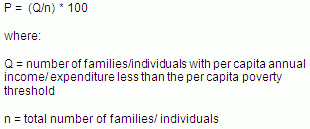
Reference: 1997 Philippine Poverty Statistics
Board Resolution: Resolution No. 2 - Series of 2007
approved: 2/14/2007
Poverty threshold (PT)
the minimum income/expenditure required for a family/individual to meet the basic food and non-food requirements
Notes: Basic food requirements are currently based on 100% adequacy for the Recommended Energy and Nutrient Intake (RENI) for protein and energy equivalent to an average of 2000 kilocalories per capita, and 80% adequacy for other nutrients. On the other hand, basic non-food requirements, indirectly estimated by obtaining the ratio of food to total basic expenditures from a reference group of families, cover expenditure on: 1) clothing and footwear; 2) housing; 3) fuel, light, water; 4) maintenance and minor repairs; 5) rental of occupied dwelling units; 6) medical care; 7) education; 8) transportation and communication; 9) non-durable furnishings; 10) household operations; and 11) personal care & effects.
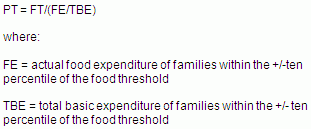
Reference: 1997 Philippine Poverty Statistics
Board Resolution: Resolution No. 2 - Series of 2007
approved: 2/14/2007
Severity of poverty (SP)
the total of the squared income/expenditure shortfall (expressed in proportion to the poverty threshold) of families/ individuals with income/expenditure below the poverty threshold, divided by the total number of families/ individuals
Notes: This is equal to the Foster-Greer-Thorbecke (FGT) family of measures with alpha = 2. It is a poverty measure, which is sensitive to the income/ expenditure distribution among the poor – the worse this distribution is, the more severe poverty is.
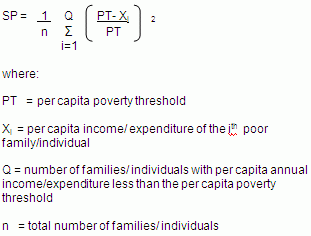
Reference: Notes on the Official Poverty Statistics in the Philippines, Series 2003-1
Board Resolution: Resolution No. 2 - Series of 2007
approved: 2/14/2007
Subsistence incidence (S)
the proportion of families/individuals with per capita income/expenditure less than the per capita food threshold to the total number of families/ individuals
Reference: 1997 Philippine Poverty Statistics
Board Resolution: Resolution No. 2 - Series of 2007
approved: 2/14/2007
Total Basic Expenditures
The aggregate of expenditures on: food; clothing and footwear; fuel; light and water; housing maintenance and other minor repairs; rental or occupied dwelling units; medical care; education; transportation and communications; non-durable furnishing; household operations and personal care and effects.
Notes: Excluded are expenditures captured by the FIES on alcoholic beverages, tobacco, recreation, durable furniture and equipment and miscellaneous expenditures
Reference: FIES
Board Resolution: Resolution No. 12 - Series of 2008 approved: 6/11/2008
Total Food Expenditures
The actual food expenditures of the family during the reference period, including food items received as gifts and consumed by the family during the reference period.
Notes: a. Food bought but not consumed are excluded. b. Consumption of domestic helper as well as persons employed by the family to do odd jobs around the house are generally excluded but may be added if they cannot be accounted for separately. c. The consumption of boarders and other persons in the same household not related to the family as well as overseas contract workers on vacation during the reference period are excluded.
Reference: FIES
Board Resolution: Resolution No. 12 - Series of 2008 approved: 6/11/2008

